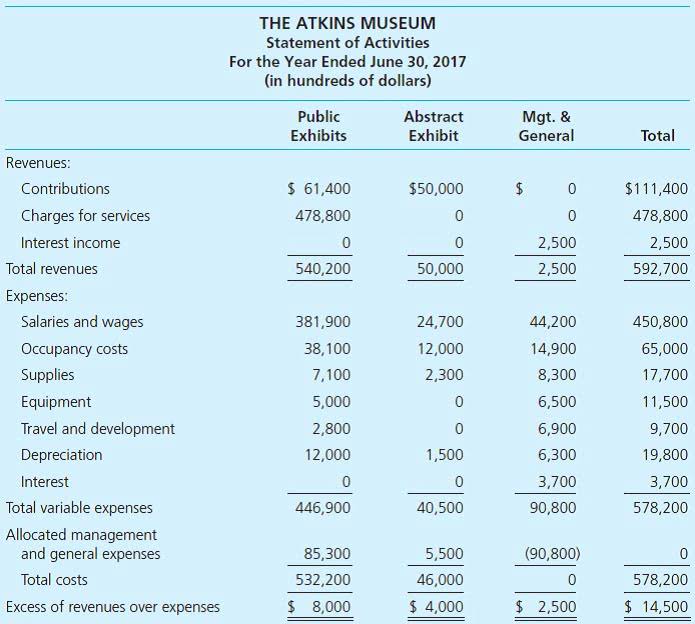Understanding the New Nonprofit Accounting Standard
| Modul | Genişlik | Derinlik | Yükseklik |

In contrast, tech companies often have higher ROAs because they generate more revenue with fewer physical assets. Even in industries where a high ROA is typical, an above-average ROA could signal a lack of reinvestment in assets, potentially jeopardizing long-term growth. It measures your organization’s income relative to its assets, including cash, inventory, and manufacturing equipment. External and direct internal investment expenses are netted with investment income and should not be included in the expense analysis. Through these funds, the organizations can pay off their current expenses as well as look around for other programs or projects that might exist.
What is an Income and Expenditure Account? (Explained)

Managing endowment funds requires a strategic approach to investment, balancing the need for income generation with the preservation of the principal. Nonprofits often establish investment policies that outline their approach to retained earnings balance sheet asset allocation, risk management, and spending. Financial reporting requirements for nonprofit organizations are designed to ensure transparency, accountability, and compliance with regulatory standards. These requirements are not just about adhering to legal mandates but also about building trust with donors, stakeholders, and the public. Accurate and comprehensive financial reporting provides a clear picture of an organization’s financial health and its ability to fulfill its mission.
Months of Liquid Unrestricted Net Assets (LUNA)
Whether you are an individual or a business, having unrestricted net assets provides you with the flexibility and security needed to navigate through various financial situations. In this section, we will delve into the importance of unrestricted net assets from different perspectives and explore how Accounting For Architects they contribute to financial freedom. NFP A has a goal to maintain financial assets, which consist of cash and short-term investments, on hand to meet 60 days of normal operating expenses, which are, on average, approximately $275,000. NFP A has a policy to structure its financial assets to be available as its general expenditures, liabilities, and other obligations come due. In addition, as part of its liquidity management, NFP A invests cash in excess of daily requirements in various short-term investments, including certificate of deposits and short-term treasury instruments.
Cash Flow Statement Presentation
Unrestricted net assets are a crucial component of financial freedom for any organization, whether it be a nonprofit, a business, or even an individual. Understanding the basics of unrestricted net assets is essential for making informed financial decisions and ensuring long-term sustainability. In this section, we will delve into the definition of unrestricted net assets from various perspectives and provide in-depth information to help you grasp its significance. Committed Fund Balances Committed fund balance represents formal constraints that have been placed on resources within fund balance through formal action of the government’s highest decisionmaking authority.
- This category of assets provides the organization with the financial flexibility to fund day-to-day operations, invest in new programs, maintain existing programs, cover administrative costs, and respond to unexpected situations or opportunities.
- Unrestricted net assets play a crucial role in the financial landscape of organizations, particularly in the nonprofit sector.
- Whatever their source, they contribute to the overall financial health of the organization as part of its unrestricted net assets.
- Additionally, nonprofits should establish a process for re-evaluating donor agreements periodically, especially if the organization’s circumstances or the donor’s intentions change over time.
- All participants must be at least 18 years of age, proficient in English, and committed to learning and engaging with fellow participants throughout the program.
Terms Defined

Unrestricted net assets are funds that a nonprofit can use at its discretion to support its general operations and any other activities that align with its mission. These assets are not bound by donor-imposed restrictions, providing the organization with the flexibility to allocate resources where they are most needed. This category often includes revenue from membership fees, service fees, and unrestricted donations. Effective management of unrestricted net assets is crucial for covering operational costs, such as salaries, utilities, and administrative expenses, ensuring the organization can function smoothly and respond to unforeseen challenges. From the perspective of nonprofit organizations, increasing unrestricted net assets is essential for long-term sustainability and growth. It enables them to invest in infrastructure, expand programs, and build reserves for unforeseen circumstances.
- For example, a donor might establish a scholarship fund that requires the principal to be preserved, with the interest earned used to award scholarships annually.
- The statement of financial position, akin to a balance sheet in for-profit entities, offers a snapshot of the organization’s financial standing at a specific point in time.
- For example, banks and financial institutions often have lower ROAs because their assets—primarily loans—earn relatively low profit margins.
- Harvard Business School Online’s Business Insights Blog provides the career insights you need to achieve your goals and gain confidence in your business skills.
- For example, an organization devoted to animal rescue may receive a restricted donation to be spent on the care and feeding of crocodiles.
Harnessing the Power of Unrestricted Net Assets for Financial Freedom
If your organization starts to dig itself into a hole wherein its Readily Available Net Assets is negative and continues to grow more negative, there will come a day when your organization’s “powers that be” realize there is a problem. Unfortunately, unless your organization can generate a lot of earned income, or find donors to fund operating deficits, it may already be too late. Situations like this are very difficult to pull out of, but can be prevented by monitoring Readily Available Net Assets along the way. First, subtract the amount of net assets that have been set aside for another purpose, such as a quasi-endowment or operating reserves, from the total unrestricted net assets. Organizations typically prefer donations of unrestricted net assets because they allow them maximum flexibility to spend as they see fit, whether for hiring additional personnel or expanding their services.
- Transparency in this process is crucial, as it demonstrates the nonprofit’s commitment to honoring donor restrictions and maintaining financial integrity.
- The creation of this type of constraint is evidenced by formal governing board actions (e.g., legislation, resolution, or ordinance) that can only be changed by an equivalent action.
- Building and preserving a reserve can provide a financial cushion during periods of uncertainty or economic downturns.
- We confirm enrollment eligibility within one week of your application for CORe and three weeks for CLIMB.
- Nonprofit organizations play a crucial role in addressing societal needs, often relying on donations and grants to fund their activities.
- The unassigned fund balance classification, as defined below, is used for special revenue, debt service, capital projects, or permanent funds only if the residual amount of fund balance is negative.
How Ryan Passed His CPA Exams During His Master’s Program

The creation of this type of constraint is evidenced by formal governing board actions (e.g., legislation, resolution, or ordinance) that can only be changed by an equivalent action. Alternatively, provide the measure of operations on the face of the financial statements by including lines such as operating revenues and operating expenses in the statement of activities. Another critical element is the Statement of Cash Flows, which details the cash inflows and outflows from operating, investing, and financing activities.
- Unrestricted net assets refer to the portion of a nonprofit organization’s net assets that is neither permanently restricted nor temporarily restricted by donor-imposed stipulations.
- Engaging board members and key stakeholders in these reviews can also provide valuable perspectives and enhance trust in the organization’s financial management practices.
- Other sources of revenue might include unrestricted grants or contributions and in some cases, it can also be through the release of the temporarily restricted net assets.
- Effectively managing unrestricted net assets requires a strategic approach that balances immediate needs with long-term goals.
A legitimate and well-run nonprofit organization will provide Form 990s, annual reports, and auditor’s reports to prospective donors for their review. While ROA and ROE are useful measurements, they should be used alongside other metrics, including net profit margin and the DuPont formula, to gain a comprehensive view of financial health. Like most profitability ratios, ROA is used to assess your company’s efficiency by comparing its performance over time or against competitors. While business leaders may find ROA helpful for internal analysis, Knight says it’s a critical component for investors and banks to consider when evaluating a company’s financial viability and risk. For example, a nonprofit focused on environmental conservation may seek corporate sponsorships from companies aligned with their mission.

Liquidity and Availability of Resources
For businesses, unrestricted net assets play a vital role in assessing the organization’s financial stability and growth potential. It represents the portion of a company’s total assets that is not subject to any restrictions or obligations. These assets can be used freely by the business for various purposes such as expanding operations, investing in what are unrestricted net assets new ventures, or paying off debts. Assigned Fund Balance.Assigned fund balance represents intentional constraints placed on resources within fund balance eitherby the governing board or its appointees. The creation of these constraints does not require formal action, although formal action to enact is not prohibited.


